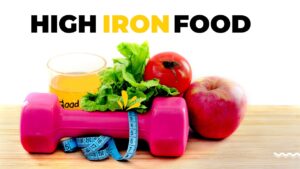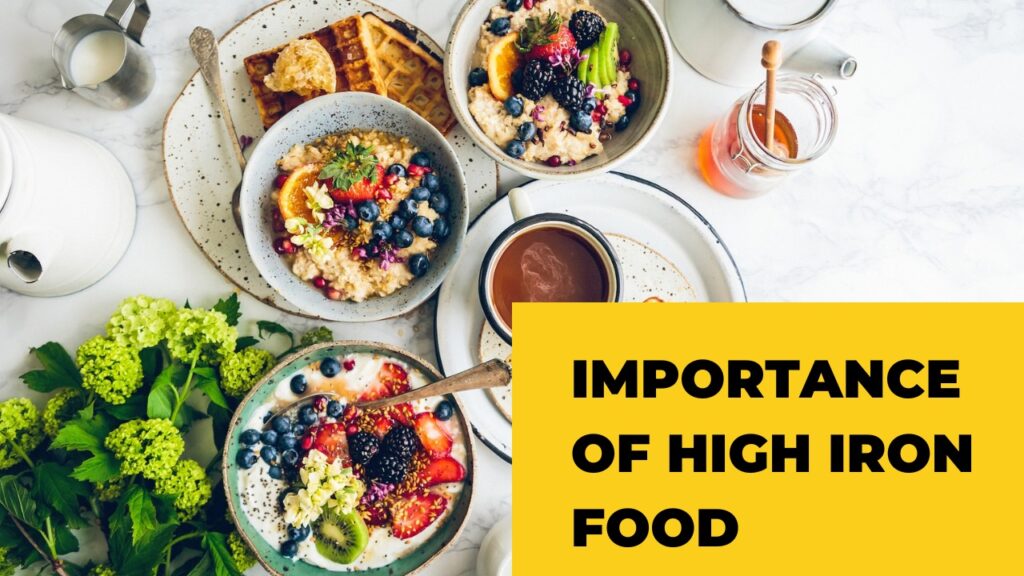Are you getting adequate iron on a daily basis? Most of us, however, are unlikely to be. Our bodies require high iron foods in order to develop and grow. Iron can also help prevent anemia and keep your body healthy. If you haven’t been eating iron-rich foods, we’ll show you some simple opportunities to integrate the above nutritional powerhouse into your diet.
Two types of iron
Food contains two types of iron: heme iron and nonheme iron. Meat, fish, and poultry all contain heme iron. It is the most easily absorbed form of iron by your body. Individuals absorb up to 30% of the heme you consume. In general, eating meat raises your iron levels far more than eating non-heme iron.
Plant based food rich in non heme iron
Plant-based foods rich in non-heme iron include fruits and vegetables which are high iron foods. Non-heme iron foods are still a crucial component of a nutritious, well-balanced diet, however, the iron in these foods is not as well absorbed. You absorb between 2% and 10% of the non-heme iron you consume.
Why are high iron foods important?
Iron is also required for brain growth and development, as well as the production of numerous cells as well as hormones throughout the body. Without adequate iron stores, people can develop iron-deficiency anemia, the most common dietary deficiency worldwide. Iron is one of the most essential minerals in the body.
Though there is less than 5 grams of iron in the body (about the size of a teaspoon), it plays an important role. The majority of it is discovered in hemoglobin as heme, which is only found in animals and not plants. This article will go over the importance of iron-rich foods to the human body.
Daily requirements of Iron for man and woman
Women require more iron to replace what is lost in their blood during menstruation. Women require roughly twice as much iron as men until menopause.
The iron defect occurs when iron levels are too low, resulting in anemia. If you are concerned about anemia, your doctor may order blood tests and recommend iron supplements. Always consult your doctor before taking iron supplements, as you could poison yourself if you take too much.
What are vegetables rich in high iron content?
Plant-based iron sources
Plant foods containing non-haem iron can still provide the body with an adequate amount of iron with high iron foods. Sources to consider include:
- Nuts
- Stale fruit
- Bread and wholemeal pasta
- Bread with iron and breakfast cereal legumes (mixed beans, baked beans, lentils, chickpeas)
- Dark green leafy vegetables (spinach, silver beet, broccoli)
- Oats
- Tofu
- Spinach
- Sweet potatoes
- Peas
- Broccoli
- String beans
- Beet greens
- Dandelion greens
- Collards
- Kale
- Chard
Let me discuss a few of them. To be well aware of the presence of iron in these foods. And what amount of iron will be helpful for the body. And if you are taking any less amount then how it is going to affect your health?
In the upcoming paragraphs, I will also explain what will happen if you do not consume high iron food.
Broccoli is a high iron food
Broccoli is one of the healthiest plant-based foods available. It contains not only iron but also vitamin C, which aids in iron absorption. Broccoli is also high in fiber, making it an ideal food for people attempting to lose weight because it fills them up.
Broccoli is also a beneficial source of vitamin K, so incorporating it into your diet is a good place to start.
Broccoli contains 6% of the daily value of iron and is high in vitamins C, K, and folate. It may also aid in reducing the risk of cancer.

Spinach as a high iron vegetable
Vegetables are an excellent source of many essential vitamins and minerals, including iron. Which are high iron foods Many leafy green vegetables contain high levels of iron. Iron-rich food in the form of vegetables includes the following:
Leafy Greens
There is no denying the significance of leafy greens as an iron-rich food as a vegetable that can provide 15% of the daily value. Other iron-rich vegetables include collard, kale, and other leafy greens.
A cup of boiled spinach includes roughly 4 g of iron (opens in a new tab) and it doesn’t have to be boring. Try Goma-ae, a Japanese side dish of boiled spinach with sesame seeds seed sauce or sauté your spinach with fresh garlic and butter.
High iron foods in the form of spinach
Spinach is an adaptable green that is high iron foods. It can be mixed into a green smoothie, cooked into a tomato sauce, topped with pizza, or packed into pasta or vegetables. Because of its mild flavor, it can be managed to sneak into kid-friendly dishes such as mac ‘n’ cheese, soups, and casseroles.
Spinach also contains many nutrients that promote healthy skin, hair, and bones, as well as lowering the risk of heart disease and aiding digestion, among other things. Which food contains iron from legumes? Legumes and beans are excellent choices for you!
Legumes and their iron content
People who consume beans and legumes can aid in iron replenishment. Legumes, such as beans, lentils, and chickpeas, can provide iron, especially if you follow a vegetarian diet. Aside from high iron foods legumes are high in soluble fiber, which aids the digestive process and keeps you fuller for longer.
Mushrooms
Despite the fact that mushrooms are considered vegetarian foods, many vegetarians dislike their texture. Those who eat mushrooms, on the other hand, are consuming iron-rich foods that provide 12.18 mg of iron per 100 grams of mushrooms.
Wrap up
Individuals with insufficient iron stores can develop iron-deficiency anemia, the most prevalent dietary deficiency worldwide. It is characterized by symptoms such as fatigue, weakness, trouble concentrating body heat, pale skin, dizziness, migraine, and an inflamed tongue. Iron-rich foods can aid in the prevention and treatment of iron deficiency anemia. These natural foods are an excellent substitute for iron tablets and blood transfusions. Even so, trying to eat these foods in moderation is the only way to ensure adequate iron levels in the blood. When looking for advice on food choices, it is best to speak with a nutritionist.

